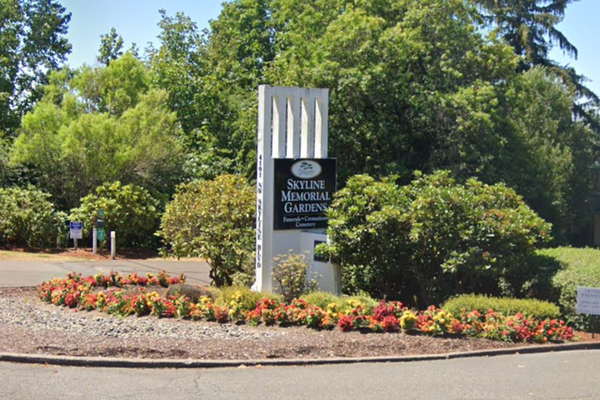LOS ANGELES — As a huge oil spill threatens Laguna Beach, Newport Beach and other cities along the Orange County coast, officials say they’re investigating the possibility that a ship’s anchor might have struck a pipeline, causing the leak.
Amplify Energy CEO Martyn Willsher said during a news conference Monday that a ship’s anchor striking the pipeline is “one of the distinct possibilities” for the cause of the massive oil spill. No additional details were provided. The Coast Guard said it was investigating that as one possible scenario, but officials did not present any evidence suggesting an anchor could be the cause.
“We have examined more than 8,000 feet of pipe and we have isolated one specific area of significant interest,” Willsher said. “We did this primarily through [remotely operated vehicles] to this point but we are sending divers down now to verify what we were seeing. There’s more information to come but I think we’re moving very closely to the source and the cause of this incident.”
Environmentalists have long criticized the general safety and maintenance of the aging offshore oil platforms. They have pointed to those factors as being possible causes.
Cargo ships heading to the ports in Los Angeles and Long Beach frequently pass through the area where the leak occurred, officials said. During the pandemic the Southern California coast has seen gridlock along the coast as dozens of container ships at a time wait to get into the ports of Los Angeles and Long Beach. It was unclear, however, how close those containers got to the offshore oil systems.
The spill, first reported Saturday morning, originated from a pipeline running from the Port of Long Beach to an offshore oil platform known as Elly. The failure caused roughly 126,000 gallons of oil to gush into the Catalina Channel, creating a slick that spanned about 8,320 acres. The spill has left oil along long stretches of sand in Newport Beach, Laguna Beach and Huntington Beach, killing fish and birds and threatening ecologically sensitive wetlands in what officials are calling an environmental catastrophe.
The oil will likely continue to encroach on Orange County beaches for the next few days, officials said.
Coast Guard officials are flying over the spill three to four times a day to map the oil’s direction and compare it with tides, currents and winds to project the potential impact to beaches south of Laguna in the coming days.
“It really is dependent on the prevailing weather conditions, but the oil continues to move in a southerly direction,” said Capt. Rebecca Ore, commander of the USCG Sector Los Angeles-Long Beach. “What we’ve seen is oiling just down to Dana Point ... and the trajectories indicate that trend could continue if the weather continues in the current fashion.”
Laguna Beach closed city beaches Sunday night after projections showed the spill reaching Crystal Cove by 10 p.m. That beach is now closed. Officials said Monday they’re seeing evidence of oil on Laguna’s beaches, specifically stretches of sand in the northern end of the city.
“Right now it varies. The oil clusters range from the size of a quarter to just particle-size droplets,” said Kevin Snow, chief of marine safety for Laguna Beach. “Beach closures are needed to protect the health and safety of the public and to allow contractors to begin oil cleanup.”
State wildlife officials on Monday announced a ban on fishing or collecting shellfish from Huntington Beach to Dana Point in the wake of the oil spill.
“The Office of Environmental Health Hazard Assessment has determined that a threat to public health is likely by fishing in the affected area or consuming fish or shellfish that may have been affected by the spill,” the California Department of Fish and Wildlife said in a news release.
The Crystal Cove beach had not reported any oil as of early Monday, but officials say that could change depending on the ocean currents throughout the day.
A few miles north, Newport Beach officials closed the city’s recreational harbor Monday morning in an effort to stem the spread of the oil, city spokesman John Pope said.
“We don’t have oil in there right now, so a huge priority is keeping oil from getting into the harbor,” Pope said.
Softball-sized clumps have washed ashore between the mouth of the Santa Ana River and 52nd Street. Much of the slick remains about a quarter-mile offshore, Pope said.
Newport Beach has not closed its beaches, but officials have asked people to stay out of the water. The Orange County Health Care Agency issued a health advisory Sunday recommending that those who may have encountered oil in the water seek medical attention.
U.S. Rep. Michelle Steel, a Republican who represents Orange County, sent a letter to Gov. Gavin Newsom on Monday urging him to join her efforts in requesting a major disaster declaration for Orange County from President Joe Biden. She sent a letter to the president Sunday seeking the declaration, which, if approved, would make additional federal assistance available for state and local agencies and individuals affected by the spill.
In Laguna Beach, officials say roughly golf-ball-sized pieces of tar have washed up along Crescent Bay, a beach known for its distinctive cove that runs about a quarter-mile in length where Cliff Drive intercepts North Coast Highway, and Shaw’s Cove.
Two contracted oil-recovery vessels known as skimmers worked off the coast of Laguna Beach overnight to prevent as much of the oil from coming ashore as possible, Snow said.
“The entire city is a marine-protected area, which means we have sensitive marine habitat and wildlife here that is protected, and we need resources to protect this unique ecosystem,” he said.
The Coast Guard is also continuing to recover as much oil as possible. Fourteen boats working Sunday afternoon recovered about 3,150 gallons of oil from the ocean and deployed 5,360 feet of floating barriers known as booms in an effort to protect the coastline, according to the U.S. Coast Guard.
Mark Shasha, 59, of Swampscott, Massachusetts, stood with his canvas Monday off the the sidewalk near Main Beach in Laguna Beach, mournful of how the oil spill was affecting the environment around him.
Shasha is with a group of about 35 painters from across the country who are spending the week in Laguna Beach as part of the Laguna Plein Air Painters Association annual outdoor painting event. He was finishing a painting of the nearby lighthouse with an empty sandy beach, closed due to the oil spill.
“I don’t have any people to paint on the beach,” he said of his painting. “I don’t have any umbrellas on the sand, nothing that gives it any spirit.”
As an outdoor painter, Shasha focuses on documenting the wildlife, sunlight and color of an exact moment in time. The orange plastic fencing bordering the beach and limiting anyone from entering prohibited him from capturing what is normally bustling life in a beautiful place. His job is to tell a story, he said.
“I just don’t want it to be a sad story,” he said. “I don’t know if anyone wants [to buy] a memento from the oil spill.”
Oil was also continuing to wash ashore in Huntington Beach early Monday.
A 5 1/2-mile stretch of sand in Huntington Beach from Seapoint Street near the Bolsa Chica wetlands to the Newport Beach city line at the Santa Ana River jetty remained closed Monday as crews continued cleanup efforts.
In Huntington Beach, which bore the brunt of the oil incursion Sunday, crews deployed 2,050 feet of booms to try to stop further incursion and protect sensitive wildlife areas, including Talbert Marsh, a 25-acre ecological reserve across from Huntington State Beach that is home to dozens of species of birds. County officials also built large sand berms in the area to keep ocean water and oil from continuing to flow into the habitat, which has already been breached by oil. Officials on Sunday requested additional booms to protect the Bolsa Chica Ecological Reserve.
Authorities are continuing to investigate the cause of the spill and say the timeline for cleaning up the area’s beaches remains unclear.
Cleanup along the shore in Huntington Beach was underway early Monday. Workers in reflective vests combed through the sand — at times on their hands and knees — scooping up oil and placing it into trash bags.
Several oiled birds were being treated at the Wetlands and Wildlife Care Center, city officials said. The Pacific Marine Mammal Center in Laguna Beach and Sea World in San Diego are also poised to accept injured fish and wildlife.
Teams from the Oiled Wildlife Care Network were on the beach at first light Sunday combing the area around Bolsa Chica State Beach and south to Laguna Beach, both in the water and on land, said Michael Ziccardi, director of the Oiled Wildlife Care Network at the University of California, Davis.
The network has a more than 50% success rate in returning oiled animals back into the environment, he said.
“California is the model for the world as far as oiled wildlife preparedness and response, and we have the best techniques and the best success of any place in the world,” he said.
Officials found three oiled birds Sunday — a brown pelican, an American coot and a duck. The pelican had extensive injuries and had to be euthanized, he said. A fourth bird, a sanderling, was found Monday. There have also been multiple sightings of oiled gulls.
Debbie McGuire, executive director of the Wetlands and Wildlife Care Center in Huntington Beach, said her group is accepting online donations to aid in the recovery effort.
Birds are more vulnerable after this type of catastrophe because of their higher body temperature, which is an average of 104 degrees, she said.
“Their feathers interplay with each other to block water from getting in. If something like oil does get in, it breaks the continuity of that feather barrier and they become really cold,” she said.
“It’s still too early to know and understand the long-term effects of what will happen,” Ziccardi said of the effect on birds and fish in the region.







